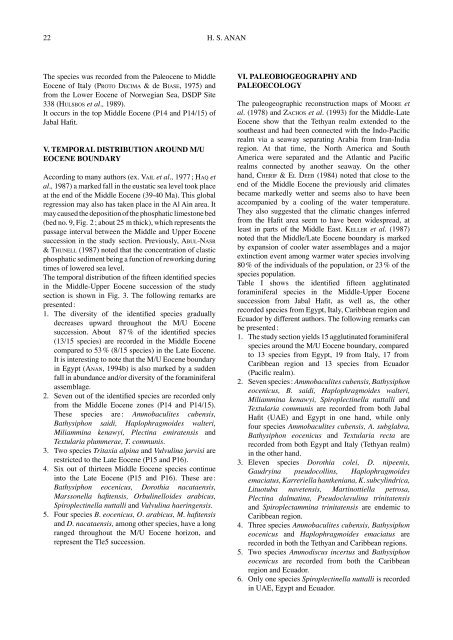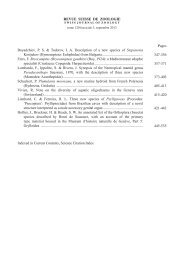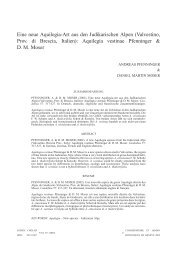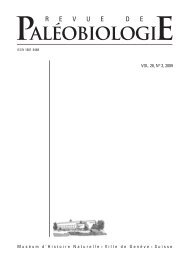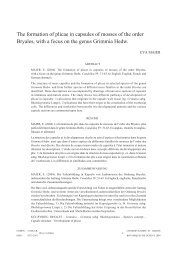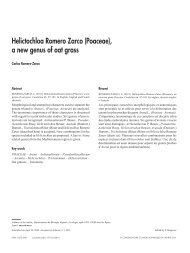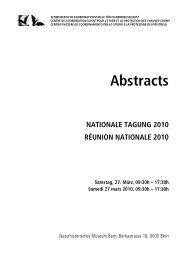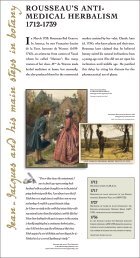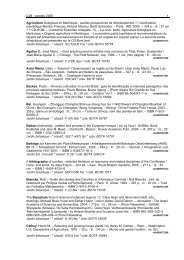Agglutinated Middle-Upper Eocene foraminifera in Jabal Hafit, Al ...
Agglutinated Middle-Upper Eocene foraminifera in Jabal Hafit, Al ...
Agglutinated Middle-Upper Eocene foraminifera in Jabal Hafit, Al ...
Create successful ePaper yourself
Turn your PDF publications into a flip-book with our unique Google optimized e-Paper software.
22 H. S. ANAN<br />
The species was recorded from the Paleocene to <strong>Middle</strong><br />
<strong>Eocene</strong> of Italy (PROTO DECIMA & de BIASE, 1975) and<br />
from the Lower <strong>Eocene</strong> of Norwegian Sea, DSDP Site<br />
338 (HULSBOS et al., 1989).<br />
It occurs <strong>in</strong> the top <strong>Middle</strong> <strong>Eocene</strong> (P14 and P14/15) of<br />
<strong>Jabal</strong> <strong>Hafit</strong>.<br />
V. TEMPORAL DISTRIBUTION AROUND M/U<br />
EOCENE BOUNDARY<br />
Accord<strong>in</strong>g to many authors (ex. VAIL et al., 1977 ; HAQ et<br />
al., 1987) a marked fall <strong>in</strong> the eustatic sea level took place<br />
at the end of the <strong>Middle</strong> <strong>Eocene</strong> (39-40 Ma). This global<br />
regression may also has taken place <strong>in</strong> the <strong>Al</strong> A<strong>in</strong> area. It<br />
may caused the deposition of the phosphatic limestone bed<br />
(bed no. 9, Fig. 2 ; about 25 m thick), which represents the<br />
passage <strong>in</strong>terval between the <strong>Middle</strong> and <strong>Upper</strong> <strong>Eocene</strong><br />
succession <strong>in</strong> the study section. Previously, ABUL-NASR<br />
& THUNELL (1987) noted that the concentration of clastic<br />
phosphatic sediment be<strong>in</strong>g a function of rework<strong>in</strong>g dur<strong>in</strong>g<br />
times of lowered sea level.<br />
The temporal distribution of the fifteen identified species<br />
<strong>in</strong> the <strong>Middle</strong>-<strong>Upper</strong> <strong>Eocene</strong> succession of the study<br />
section is shown <strong>in</strong> Fig. 3. The follow<strong>in</strong>g remarks are<br />
presented :<br />
1. The diversity of the identified species gradually<br />
decreases upward throughout the M/U <strong>Eocene</strong><br />
succession. About 87 % of the identified species<br />
(13/15 species) are recorded <strong>in</strong> the <strong>Middle</strong> <strong>Eocene</strong><br />
compared to 53 % (8/15 species) <strong>in</strong> the Late <strong>Eocene</strong>.<br />
It is <strong>in</strong>terest<strong>in</strong>g to note that the M/U <strong>Eocene</strong> boundary<br />
<strong>in</strong> Egypt (ANAN, 1994b) is also marked by a sudden<br />
fall <strong>in</strong> abundance and/or diversity of the <strong>foram<strong>in</strong>ifera</strong>l<br />
assemblage.<br />
2. Seven out of the identified species are recorded only<br />
from the <strong>Middle</strong> <strong>Eocene</strong> zones (P14 and P14/15).<br />
These species are : Ammobaculites cubensis,<br />
Bathysiphon saidi, Haplophragmoides walteri,<br />
Miliamm<strong>in</strong>a kenawyi, Plect<strong>in</strong>a emiratensis and<br />
Textularia plummerae, T. communis.<br />
3. Two species Tritaxia alp<strong>in</strong>a and Vulvul<strong>in</strong>a jarvisi are<br />
restricted to the Late <strong>Eocene</strong> (P15 and P16).<br />
4. Six out of thirteen <strong>Middle</strong> <strong>Eocene</strong> species cont<strong>in</strong>ue<br />
<strong>in</strong>to the Late <strong>Eocene</strong> (P15 and P16). These are :<br />
Bathysiphon eocenicus, Dorothia nacataensis,<br />
Marssonella hafitensis, Orbul<strong>in</strong>elloides arabicus,<br />
Spiroplect<strong>in</strong>ella nuttalli and Vulvul<strong>in</strong>a haer<strong>in</strong>gensis.<br />
5. Four species B. eocenicus, O. arabicus, M. hafitensis<br />
and D. nacataensis, among other species, have a long<br />
ranged throughout the M/U <strong>Eocene</strong> horizon, and<br />
represent the Tle5 succession.<br />
VI. PALEOBIOGEOGRAPHY AND<br />
PALEOECOLOGY<br />
The paleogeographic reconstruction maps of MOORE et<br />
al. (1978) and ZACHOS et al. (1993) for the <strong>Middle</strong>-Late<br />
<strong>Eocene</strong> show that the Tethyan realm extended to the<br />
southeast and had been connected with the Indo-Pacific<br />
realm via a seaway separat<strong>in</strong>g Arabia from Iran-India<br />
region. At that time, the North America and South<br />
America were separated and the Atlantic and Pacific<br />
realms connected by another seaway. On the other<br />
hand, CHERIF & EL DEEB (1984) noted that close to the<br />
end of the <strong>Middle</strong> <strong>Eocene</strong> the previously arid climates<br />
became markedly wetter and seems also to have been<br />
accompanied by a cool<strong>in</strong>g of the water temperature.<br />
They also suggested that the climatic changes <strong>in</strong>ferred<br />
from the <strong>Hafit</strong> area seem to have been widespread, at<br />
least <strong>in</strong> parts of the <strong>Middle</strong> East. KELLER et al. (1987)<br />
noted that the <strong>Middle</strong>/Late <strong>Eocene</strong> boundary is marked<br />
by expansion of cooler water assemblages and a major<br />
ext<strong>in</strong>ction event among warmer water species <strong>in</strong>volv<strong>in</strong>g<br />
80 % of the <strong>in</strong>dividuals of the population, or 23 % of the<br />
species population.<br />
Table I shows the identified fifteen agglut<strong>in</strong>ated<br />
<strong>foram<strong>in</strong>ifera</strong>l species <strong>in</strong> the <strong>Middle</strong>-<strong>Upper</strong> <strong>Eocene</strong><br />
succession from <strong>Jabal</strong> <strong>Hafit</strong>, as well as, the other<br />
recorded species from Egypt, Italy, Caribbean region and<br />
Ecuador by different authors. The follow<strong>in</strong>g remarks can<br />
be presented :<br />
1. The study section yields 15 agglut<strong>in</strong>ated <strong>foram<strong>in</strong>ifera</strong>l<br />
species around the M/U <strong>Eocene</strong> boundary, compared<br />
to 13 species from Egypt, 19 from Italy, 17 from<br />
Caribbean region and 13 species from Ecuador<br />
(Pacific realm).<br />
2. Seven species : Ammobaculites cubensis, Bathysiphon<br />
eocenicus, B. saidi, Haplophragmoides walteri,<br />
Miliamm<strong>in</strong>a kenawyi, Spiroplect<strong>in</strong>ella nuttalli and<br />
Textularia communis are recorded from both <strong>Jabal</strong><br />
<strong>Hafit</strong> (UAE) and Egypt <strong>in</strong> one hand, while only<br />
four species Ammobaculites cubensis, A. subglabra,<br />
Bathysiphon eocenicus and Textularia recta are<br />
recorded from both Egypt and Italy (Tethyan realm)<br />
<strong>in</strong> the other hand.<br />
3. Eleven species Dorothia colei, D. nipeenis,<br />
Gaudry<strong>in</strong>a pseudocoll<strong>in</strong>s, Haplophragmoides<br />
emaciatus, Karreriella hantkeniana, K. subcyl<strong>in</strong>drica,<br />
Lituotuba navetensis, Mart<strong>in</strong>ottiella petrosa,<br />
Plect<strong>in</strong>a dalmat<strong>in</strong>a, Pseudoclavul<strong>in</strong>a tr<strong>in</strong>itatensis<br />
and Spiroplectamm<strong>in</strong>a tr<strong>in</strong>itatensis are endemic to<br />
Caribbean region.<br />
4. Three species Ammobaculites cubensis, Bathysiphon<br />
eocenicus and Haplophragmoides emaciatus are<br />
recorded <strong>in</strong> both the Tethyan and Caribbean regions.<br />
5. Two species Ammodiscus <strong>in</strong>certus and Bathysiphon<br />
eocenicus are recorded from both the Caribbean<br />
region and Ecuador.<br />
6. Only one species Spiroplect<strong>in</strong>ella nuttalli is recorded<br />
<strong>in</strong> UAE, Egypt and Ecuador.


